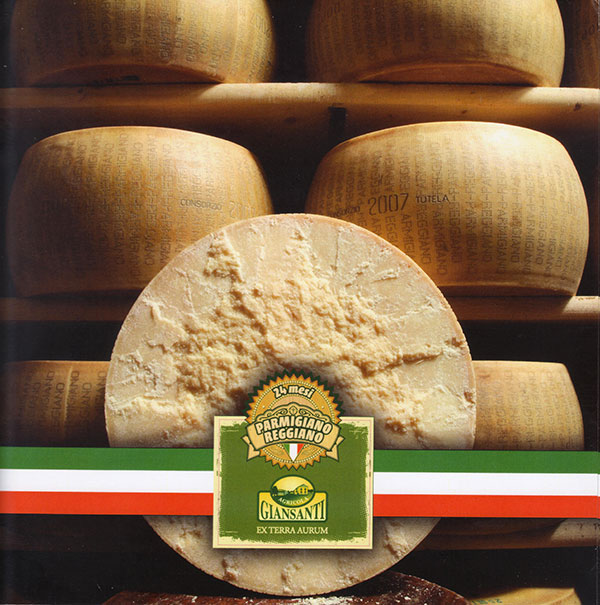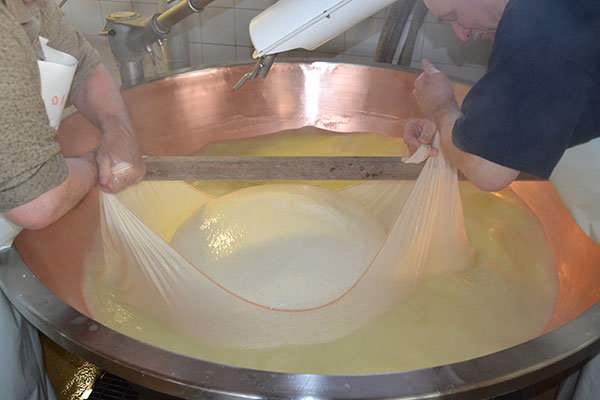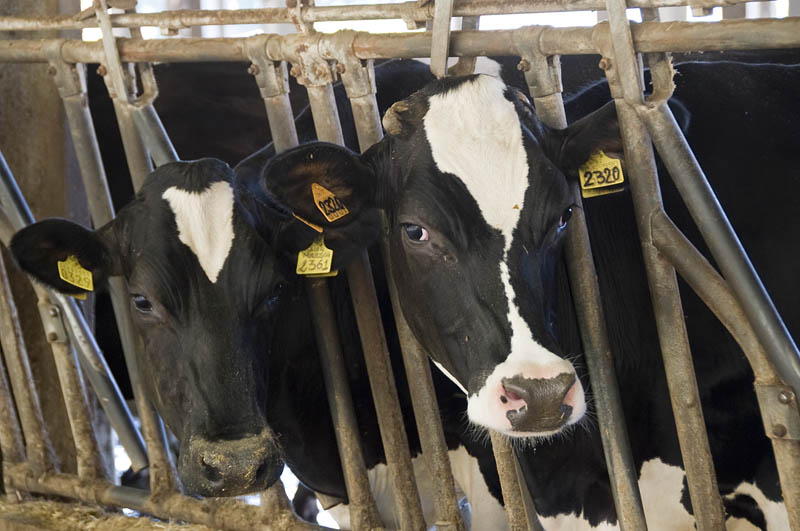 Massimiliano Giansanti, owner of the Agricola Giansanti, proudly explains: «On the road leading to the hills of Traversetolo, just outside the town of Parma, close to the beneficial waters of the thermal baths ‘Terme di Monticelli’, for more than sixty years an excellent Parmigiano Reggiano has been produced. In the same farmhouse within which there were both maturing room and cheese factory, that has been now renovated according to the highest standards in order to meet the rigorous hygiene - health protocols of the producers association Consorzio del Formaggio Parmigiano Reggiano, every day we process only our milk. It comes from the modern cowshed built just next to the old farmhouse, in order to obtain a local product. Our herd consists of 250 head of cattle. Every year we process 1,300,000 litres of milk, for an annual production of about 2,200 Parmigiano Reggiano cheeses». Giansanti exports to Europe (Germany and Norway) and Asia (China, Hong Kong, South Korea).
Massimiliano Giansanti, owner of the Agricola Giansanti, proudly explains: «On the road leading to the hills of Traversetolo, just outside the town of Parma, close to the beneficial waters of the thermal baths ‘Terme di Monticelli’, for more than sixty years an excellent Parmigiano Reggiano has been produced. In the same farmhouse within which there were both maturing room and cheese factory, that has been now renovated according to the highest standards in order to meet the rigorous hygiene - health protocols of the producers association Consorzio del Formaggio Parmigiano Reggiano, every day we process only our milk. It comes from the modern cowshed built just next to the old farmhouse, in order to obtain a local product. Our herd consists of 250 head of cattle. Every year we process 1,300,000 litres of milk, for an annual production of about 2,200 Parmigiano Reggiano cheeses». Giansanti exports to Europe (Germany and Norway) and Asia (China, Hong Kong, South Korea).
For the Agricola Giansanti, where farming exclusively consists of Friesian and Alpine Brown cows, three points are of paramount importance in the production of Parmigiano: milk, processing in the dairy, seasoning, as Giansanti specifies: «In the morning, the milk left to rest from the previous evening, which is then naturally skimmed, is poured into copper cauldrons along with the whole milk which just arrived, fresh from the morning milking. Inside the cauldrons, characterized by the typical upturned bell shape, the milk tends to clot. With a skimmer, an ancient tool in wood and iron, our master dairyman makes long and wise movements, which give the curd a grainy texture. Still in the cauldrons, these granules are cooked at 55 degrees for 50 minutes, after which a single mass of cheese forms». This mass is cut into two parts which, wrapped in cloth, are placed in the moulds, that give Parmigiano Reggiano its typical shape, with the indication of production month and year, the serial number of the dairy, and the unmistakable pitting along the circumference of the cheese. Each cheese is then further identified by a unique casein plate, which shows a progressive number. The cheeses are then placed in large tanks filled with water and sea salt. After salting, about a month after being produced, the cheeses are taken to the ‘casera’, the storehouse for cheese ripening. In the silence of the storehouses, the cheeses form long lines.
 The cheeses are placed to rest on wooden planks, side by side, a plank above the other one, so that they form entire walls of Parmigiano Reggiano. They are similar to walls characterized by light and shade effects, ranging from white of fresh cheeses to pale yellow of the more mature ones. «In this environment, with controlled temperature and humidity, the cheese is left to rest under the watchful eyes of master dairyman. The outside of Parmigiano dries and forms a natural rind, without any treatment, so that it is perfectly edible. After 12 months, the experts of the producers association examine the cheeses with typing and tapping operations, one by one, and apply the branding only on the ones they consider suitable for the DOP mark. All the marks and dotted inscription are removed from the cheeses which do not show the requirements for the DOP.
The cheeses are placed to rest on wooden planks, side by side, a plank above the other one, so that they form entire walls of Parmigiano Reggiano. They are similar to walls characterized by light and shade effects, ranging from white of fresh cheeses to pale yellow of the more mature ones. «In this environment, with controlled temperature and humidity, the cheese is left to rest under the watchful eyes of master dairyman. The outside of Parmigiano dries and forms a natural rind, without any treatment, so that it is perfectly edible. After 12 months, the experts of the producers association examine the cheeses with typing and tapping operations, one by one, and apply the branding only on the ones they consider suitable for the DOP mark. All the marks and dotted inscription are removed from the cheeses which do not show the requirements for the DOP.
There are three main seasoning for the cheese produced by Agricola Giansanti: 12, 24, and more than 30 months.
12 mesi Fresco (Fresh - 12 months)
«Every ripening hides and brings with it its own fragrances and aromas. Twelve months is the minimum maturation period, in which the cheese develops and matures all the nutritional characteristics which distinguish it». Parmigiano Reggiano 12 mesi Fresco is characterized by a soft and round taste, milky white colour, and its texture is still partially granular. For these reasons, it is primarily recommended as a table cheese, suited to be consumed during an aperitif or as a starter in the family meals.
Due Anni (two years)
«Twenty-four months are the right maturation in order to give to our Parmigiano Reggiano the best compromise between the round taste of fresh cheese and the most flavoured one of the Stravecchio one». Parmigiano Reggiano Due Anni is characterized by a soft taste, with a more definite veiled nuance, a deep white colour, and a semi-crumbly consistency. It is perfect both as table cheese, for cocktails, lunches and dinners, and for grating it, in order to give the courses a unique and unmistakable aroma.
Stravecchio (very mature)
A Parmigiano cheese matured for over 30 months is characterized by the complex of its nutritional properties, that is fully developed and whose mix of proteins and vitamins make it ideal for both athletes and the Mediterranean diet. Parmigiano Reggiano Stravecchio by the Agricola Giansanti is unique for its aromas and structure: «Its flavour is definite. Its hidden fragrances and aromas are revealed on the palate. Its colour is light straw yellow and its texture, also thanks to the fundamental value which comes from working only the milk of our cowshed, is slightly crumbly». All this makes it suitable to be eaten alone, in slivers, or combined with jams and marmalades, and also grated to enrich pasta, as well as pizza, vegetables and meat, both fresh and cooked.
